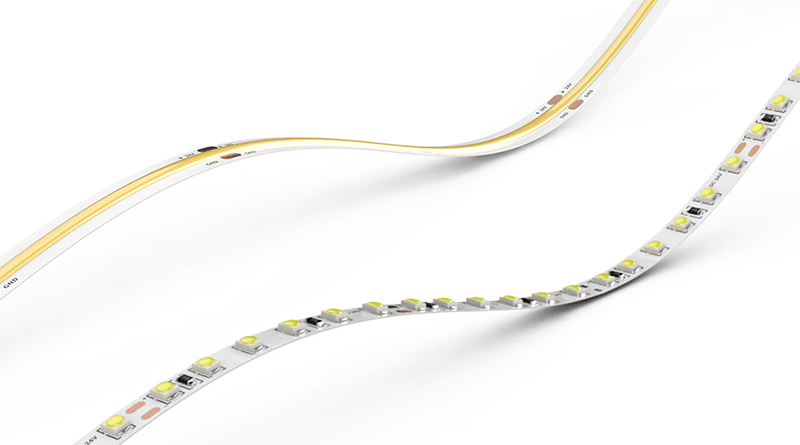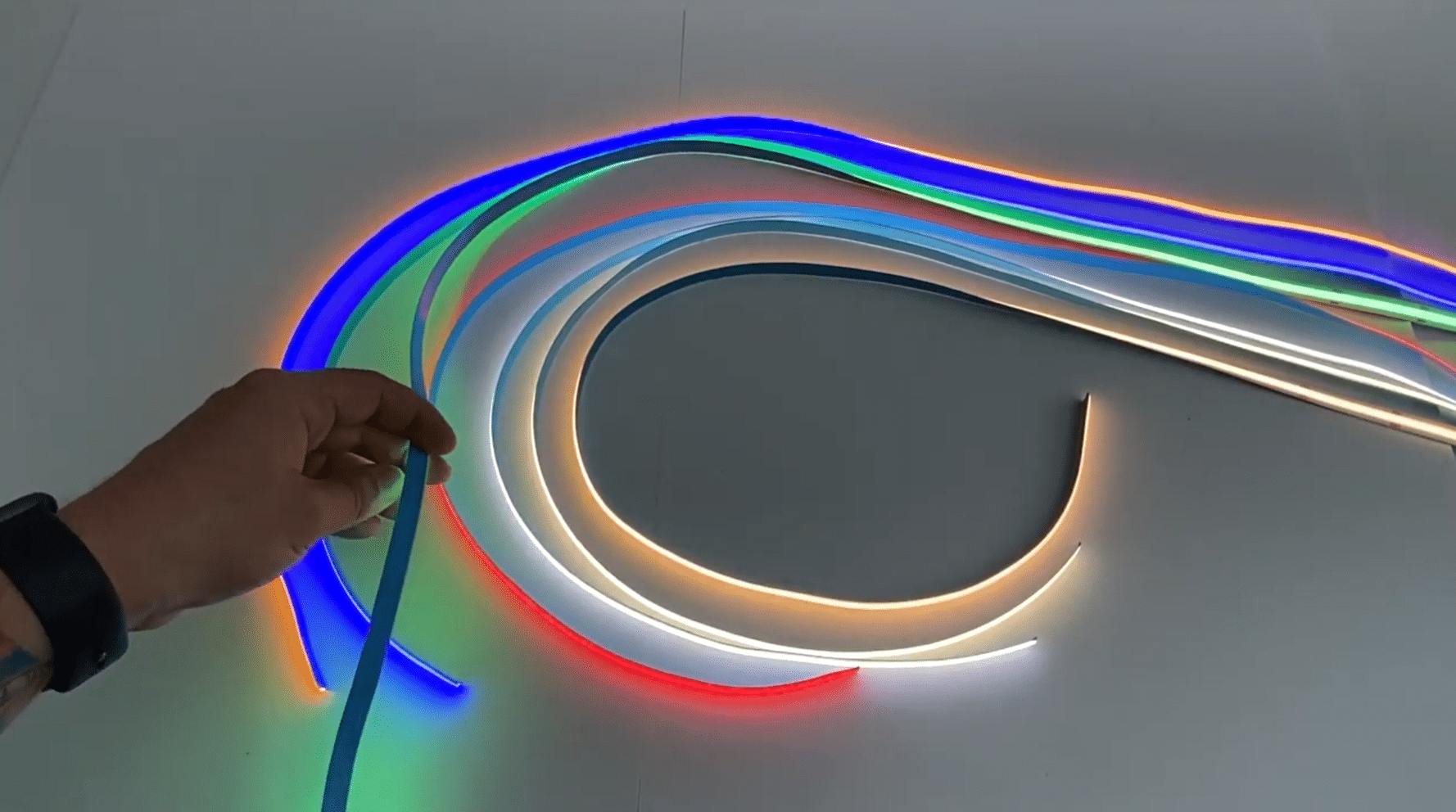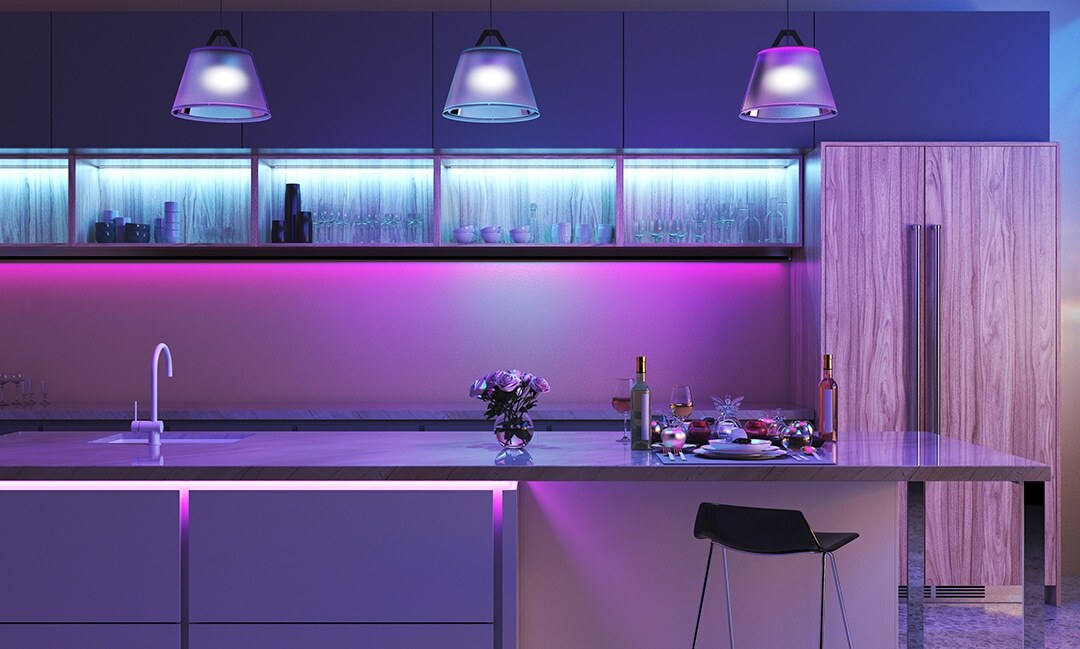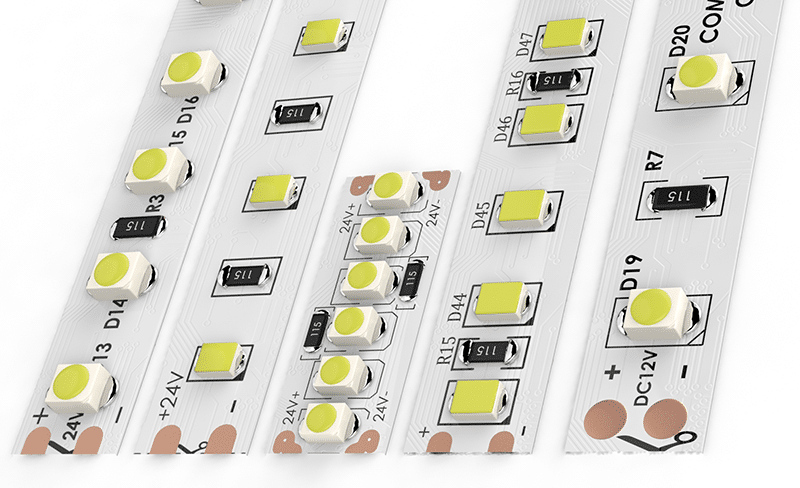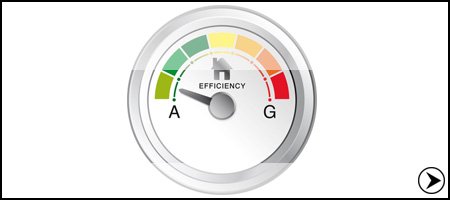- What is COB LED Lighting?
- What is SMD LED Lighting?
- How much brighter is COB over SMD?
- Does COB output smoother light then SMD?
- Does COB have a wider angle than SMD?
- Are COB and SMD Strip Lights installed the same way?
- How much energy does COB Led strip lights use compared to SMD LED Strip Lights?
- Do COB LED Strip Lights cost more than SMD LED Strip Lights?
- Will COB LED Strip Lights last as long as SMD LED Strip Lights?
- Will COB LED Strip Lights get hotter when running compared to SMD LED Strip Lights?
- Do COB LED Strip Lights use the same wattage as SMD LED Strip Lights?
- What are the cut points on COB LED Strip Lights?
- Can COB LED Strip Lights change colour?
- Can COB LED Strip Lights be controlled using DMX?
- Do COB LED Strip Lights need a different controller to SMD LED Strip Lights?
- When is it best to use COB LED over SMD LED?
What is COB LED Lighting?
COB LED stands for Chip-on-Board LED. It is a type of LED light that consists of multiple LED chips mounted directly onto a circuit board. This creates a single, compact light source that is brighter and more efficient than traditional LED lights.
What is SMD LED Lighting?
SMD LED stands for Surface-Mount Device LED. It is a type of LED that is soldered directly onto a printed circuit board (PCB). This makes them smaller and easier to manufacture than traditional LED packages, which have wires that need to be connected to the PCB.
How much brighter is COB over SMD?
COB LEDs are generally brighter than SMD LEDs. COB LEDs can produce up to three times more light than traditional LED lights, including SMD LEDs. This is because COB LEDs have multiple LED chips mounted directly onto a circuit board, while SMD LEDs have only one chip. The increased number of chips in COB LEDs allows for more light to be produced.
Here is a table comparing the brightness of COB and SMD LEDs:
| SMD | COB | |
|---|---|---|
| 5W LED Strip Lights | 480 Lumens | 576 Lumens |
| 10W LED Strip Lights | 960 Lumens | 1152 Lumens |
| 15w LED Strip Lights | 1440 Lumens | 1728 Lumens |
As you can see, COB LEDs have a higher lumens per watt ratio than SMD LEDs. This means that COB LEDs produce more light for the same amount of electricity.
Does COB output smoother light then SMD?
COB LEDs generally produce smoother light than SMD LEDs. This is because the multiple chips in COB LEDs are spread out evenly over the surface of the circuit board. This helps to eliminate shadows and hotspots, resulting in a more pleasing light source.
SMD LEDs, on the other hand, have individual chips that are spaced closer together. This can create a slightly uneven light distribution, with visible shadows and hotspots.
Does COB have a wider angle than SMD?
COB LEDs generally have a wider beam angle than SMD LEDs. This is because COB LEDs have multiple chips mounted directly onto a circuit board, which allows for a wider distribution of light. SMD LEDs, on the other hand, have only one chip, which produces a more narrow beam of light.
Of course, the specific beam angle of an LED can vary depending on the manufacturer and the specific LED model. However, in general, COB LEDs have a wider beam angle than SMD LEDs.
Are COB and SMD Strip Lights installed the same way?
COB and SMD strip lights are generally installed in a similar manner, with some minor differences due to their different packaging structures. Here’s a comparison of their installation processes:
COB Strip Lights Installation:
Clean the surface: Clean the surface where you’ll be attaching the COB strip lights to remove dirt, dust, and grease. Use alcohol or rubbing alcohol for effective cleaning.
Measure and cut the strip lights: Determine the required length of COB strip lights and cut them along designated cutting marks using scissors or wire cutters.
Connect the power supply: Attach the power supply connector to the COB strip lights, ensuring proper polarity. Most COB strip lights have clear markings for positive (+) and negative (-) terminals.
Mount the strip lights: Peel off the adhesive backing on the COB strip lights and carefully adhere them to the clean surface. Use mounting clips for additional support if needed.
Test the lights: Plug in the power supply and turn on the lights. If the lights fail to illuminate, check the connections and ensure correct polarity.
SMD Strip Lights Installation:
Clean the surface: Clean the surface thoroughly to remove any contaminants that could interfere with adhesion. Use alcohol or rubbing alcohol for effective cleaning.
Measure and cut the strip lights: Determine the required length of SMD strip lights and cut them along designated cutting marks using scissors or wire cutters.
Attach the end caps: Attach end caps to the cut ends of the SMD strip lights to protect the exposed circuit board and prevent moisture damage, especially for outdoor applications.
Connect the power supply: Attach the power supply connector to the SMD strip lights, ensuring proper polarity. Most SMD strip lights have clear markings for positive (+) and negative (-) terminals.
Mount the strip lights: Peel off the adhesive backing on the SMD strip lights and carefully adhere them to the clean surface. Use mounting clips for additional support if needed.
Test the lights: Plug in the power supply and turn on the lights. If the lights fail to illuminate, check the connections and ensure correct polarity.
Key Differences:
COB strip lights typically require no soldering, while SMD strip lights may require soldering for certain applications, especially when connecting multiple lengths or using waterproof versions.
SMD strip lights may require end caps to protect the exposed circuit board and prevent moisture damage, while COB strip lights generally have a more robust design that doesn’t necessitate end caps.
How much energy does COB Led strip lights use compared to SMD LED Strip Lights?
COB LED strip lights are generally more energy efficient than SMD LED strip lights. This is because COB LEDs are more densely packed together, which allows them to produce more light per watt. SMD LEDs are typically spaced further apart, which makes them less efficient.
Here is a table that compares the energy efficiency of COB and SMD LED strip lights:
| Type of LED Strip Light | Lumens per Watt |
|---|---|
| COB LED strip lights | 80-120 |
| SMD LED strip lights | 50-80 |
As you can see, COB LED strip lights produce up to 40% more light per watt than SMD LED strip lights. This means that you will need to use fewer COB LED strip lights to achieve the same level of brightness as SMD LED strip lights. This will save you energy and money in the long run.
Do COB LED Strip Lights cost more than SMD LED Strip Lights?
COB LED strip lights typically cost more than SMD LED strip lights. This is because COB LEDs are more densely packed together, which requires more manufacturing materials and a more complex manufacturing process. As a result, COB LED strip lights are typically about 20-30% more expensive than SMD LED strip lights.
However, there are some advantages to using COB LED strip lights that may make them worth the extra cost. First, COB LED strip lights are more energy efficient than SMD LED strip lights. This is because COB LEDs are able to produce more light per watt. Second, COB LED strip lights produce a more uniform light, without the “spotty” appearance that can be seen with SMD LED strip lights. Finally, COB LED strip lights are more durable than SMD LED strip lights. This is because the LEDs are more tightly packed together, which makes them less susceptible to damage from shock or vibration.
So, if you are looking for the most energy-efficient, uniform, and durable LED strip lights, then COB LED strip lights are a good option. However, if you are on a tight budget, then SMD LED strip lights may be a better choice.
| Feature | COB LED Strip Lights | SMD LED Strip Lights |
|---|---|---|
| Energy Efficiency | More energy efficient | Less energy efficient |
| Light Uniformity | More uniform light | Can be spotty |
| Heat Dissipation | Can run hotter | Cooler operation |
| Durability | More durable | Less durable |
| Cost | Typically more expensive | Typically less expensive |
Will COB LED Strip Lights last as long as SMD LED Strip Lights?
Both COB and SMD LED strip lights are known for their long lifespan, with an average lifespan of 50,000 to 100,000 hours. This means that they can last for several years, even if they are used for multiple hours per day.
However, there are some factors that can affect the lifespan of LED strip lights, including:
Quality of the LED chips: The quality of the LED chips used in the strip lights will have a major impact on their lifespan. Higher-quality LED chips will typically last longer than lower-quality chips.
Operating temperature: LED strip lights should be operated within their recommended temperature range. If they are operated too hot, they will degrade faster.
Humidity: LED strip lights should not be exposed to high levels of humidity. Humidity can cause the LED chips to corrode, which can shorten their lifespan.
Dimming: Dimming LED strip lights can put additional stress on the LEDs, which can shorten their lifespan. If you need to dim your LED strip lights, use a dimmer that is specifically designed for LEDs.
In general, COB LED strip lights tend to last slightly longer than SMD LED strip lights. This is because COB LEDs are better at dissipating heat, which can help to extend their lifespan. However, the difference in lifespan is relatively small, and both types of LED strip lights should last for several years.
Will COB LED Strip Lights get hotter when running compared to SMD LED Strip Lights?
COB LED strip lights typically get hotter when running compared to SMD LED strip lights. This is because COB LEDs are more densely packed together, which generates more heat. SMD LEDs are spaced further apart, which helps to dissipate heat more effectively. Additionally, COB LEDs are generally more powerful than SMD LEDs, which also contributes to their higher heat generation.
Do COB LED Strip Lights use the same wattage as SMD LED Strip Lights?
COB LED strip lights typically use more wattage than SMD LED strip lights. This is because COB LEDs are packed more closely together, which generates more heat. SMD LEDs are spaced further apart, which allows them to dissipate heat more effectively and operate at a lower wattage.
The wattage of an LED strip light is determined by the number of LEDs and the power they consume. COB LED strip lights typically have more LEDs per foot than SMD LED strip lights, and they also consume more power per LED. As a result, COB LED strip lights typically use more wattage than SMD LED strip lights.
| Type of LED Strip Light | Wattage per Foot |
|---|---|
| COB LED strip lights | 5-20 watts |
| SMD LED strip lights | 3-12 watts |
What are the cut points on COB LED Strip Lights?
COB LED strip lights come in a wide variety of colors, including:
RGB: RGB LED strip lights are the most versatile type of LED strip light, as they can produce a wide range of colors by mixing red, green, and blue LEDs.
RGBW: RGBW LED strip lights are similar to RGB LED strip lights, but they also have a dedicated white LED chip. This allows them to produce a wider range of colors, including true white and pastel shades.
Single-color: Single-color COB LED strip lights are available in a variety of colors, including red, green, blue, yellow, white, and pink.
White: White COB LED strip lights can be adjusted to produce any color temperature from warm white to cool white.
Can COB LED Strip Lights change colour?
COB LED strip lights can change color. They are available in a variety of RGB, RGBW, and single-color options as mentioned above.
To change the color of a COB LED strip light, you will need a controller. There are a variety of controllers available, including remote controls, smartphone apps, and voice assistants. The controller will allow you to select the desired color, brightness, and other features of the lights.
Can COB LED Strip Lights be controlled using DMX?
COB LED strip lights can be controlled using DMX. DMX is a digital lighting control protocol that is widely used in the professional lighting industry. It is a reliable and versatile protocol that can be used to control a wide variety of lighting fixtures, including LED strip lights.
To control COB LED strip lights using DMX, you will need a DMX decoder. A DMX decoder converts the DMX signal into a format that can be understood by the LED strip lights. The decoder will also allow you to control the brightness, color, and other features of the lights.
Do COB LED Strip Lights need a different controller to SMD LED Strip Lights?
COB LED strip lights and SMD LED strip lights require different controllers. This is because the two types of LED strip lights have different electrical characteristics. COB LED strip lights typically have a higher voltage and amperage than SMD LED strip lights. As a result, they require a controller that is specifically designed for COB LED strip lights.
COB LED strip lights are typically controlled using a constant voltage (CV) controller. A CV controller maintains a constant voltage to the LED strip lights, regardless of the load. This is important because COB LED strip lights can draw a lot of current, and a CV controller will ensure that the lights do not overheat or damage.
SMD LED strip lights, on the other hand, are typically controlled using a constant current (CC) controller. A CC controller maintains a constant current to the LED strip lights, regardless of the voltage. This is important because SMD LED strip lights are more sensitive to voltage fluctuations, and a CC controller will help to protect the lights from damage.
In addition to the type of controller, COB LED strip lights and SMD LED strip lights also have different connectors. COB LED strip lights typically use a 5-pin connector, while SMD LED strip lights typically use a 4-pin connector. This is important because the connectors are not compatible with each other.
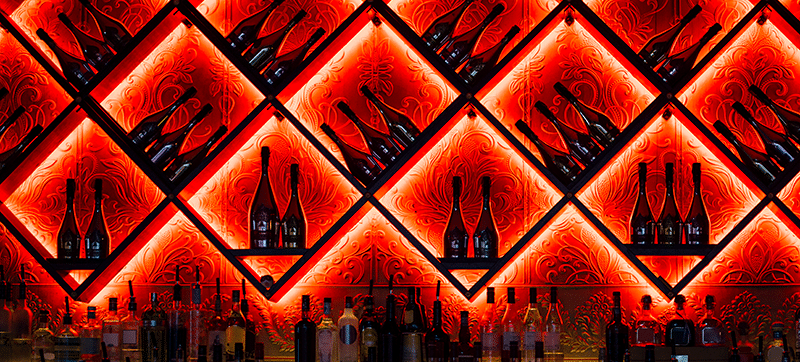
When is it best to use COB LED over SMD LED?
COB and SMD LEDs both have their own unique advantages and disadvantages, making them suitable for different applications. Here’s a summary of when to choose COB LED over SMD LED:
Choose COB LEDs when:
Brightness is crucial: COB LEDs produce significantly higher light output compared to SMD LEDs, making them ideal for applications where intense illumination is essential.
Uniform light distribution is essential: COB LEDs offer a smoother, more uniform light distribution, eliminating visible shadows and hotspots. This makes them suitable for task lighting, architectural lighting, and applications where a seamless visual appearance is desired.
Wider beam angle is needed: COB LEDs typically have a wider beam angle, spreading light across a larger area. This makes them suitable for general illumination, stage lighting, and applications where broad coverage is required.
Heat dissipation is not a major concern: COB LEDs generate more heat compared to SMD LEDs. Ensure the application area has adequate heat management if using COB LEDs.
Choose SMD LEDs when:
Cost-effectiveness is paramount: SMD LEDs are generally more affordable than COB LEDs, making them a cost-effective choice for budget-conscious applications.
Compactness is crucial: SMD LEDs are smaller and more compact than COB LEDs, making them suitable for applications where space is limited.
Versatility in color temperature is needed: SMD LEDs offer a wider range of color temperature options, catering to diverse lighting needs.
Durability and reliability are essential: SMD LEDs are known for their durability and long lifespan, making them suitable for applications that require ruggedness and longevity.
Ultimately, the choice between COB and SMD LEDs depends on the specific requirements of the application. Consider factors like brightness, light distribution, beam angle, cost, compactness, versatility, and durability to make an informed decision.








